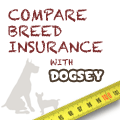Dog FoodDog food comes in a variety of shapes and sizes – and choosing the right dog food for your dog will be one of the most important decisions you make. Well there’s certainly no shortage of choice. There’s… dry food, mixers, tinned food, raw dog food (often referred to as the barf diet), frozen (when you buy it not when you feed it!). Then you have variances within those; species-appropriate dog food, natural dog food, organic dog food, and dog food containing preservatives and additives – it can certainly be a confusing subject! When you acquire your dog, whether from a breeder or a rescue centre, you are often given a few days supply of the dog food and water your dog is used to. It might be an idea to acquire at least a few weeks supply of the same dog food whilst you consider which food you are going to feed your dog. When changing a dog’s diet, you would normally gradually add some of the ‘new’ food at feeding times to the bowl of old food, slowly increasing the quantity of the new food added to the bowl (and respectively decreasing the food) over say a two week period, until you reach the stage when you are feeding the new dog food by itself – it’s best to spread this out over about two weeks because it gives your dog’s digestive system a chance to get used to the new dog food. Of course there are exceptions - such as when moving to RAW, when it is usually done straight away without mixing. So what are the differences in dog food? Dry dog food is dog food that has been baked or cooked and then ‘dried’ into small cubes or shapes. One of the major benefits of dry food is that it helps keep your dogs teeth in good condition as the chewing action helps remove plaque. Dry dog food is normally ‘complete’ meaning it contains all the recommended daily vitamins and minerals for a dog’s daily diet. There are many kinds of dry dog food that you can buy, including organic, holistic and natural. You even get a variety that are specially created for different kinds of dogs. Whether that's for puppies, junior dogs, adults, seniors, or even for lactating bitches or those recovering from surgery. Mixer Dog food Mixer, is ‘dry’ dog food, but generally, it is not a ‘complete’ food and is intended to be ‘mixed’ with tinned dog food or other foods. Its original use was that it added ‘bulk’ to the food at feeding times and was therefore used to help with dogs that ate excessively and needed to cut their calorie intake. However these days dog mixers are not so widely used, as other foods, particularly as ‘complete’ dry dog foods come in various packages aimed at different kinds of dogs (including overweight dogs). Tinned Tinned dog food is nearly always a complete dog food, and is normally food that has been cooked, with gravy or jelly added to it – so it’s very much a ‘wet’ dog food. However as with any tinned food, it is a good idea to keep an eye out for artificial colours, flavours or preservatives and exercise your own judgement when buying. RAW Dog Food RAW Feeding has seen a bit of a resurrection of late, with more and more dog owners wishing to stay clear of grain based diets for their dogs - believing that dog cannot digest grains (as well as all the other additives) properly. It's commonly accepted in the Raw Feeding community to feed 80% meat, 10% bone/tripe and 10% vegetables - but there are no hard and fast rules. It has become so popular that we now have a Raw Dog Feeding Forum in our community forums. Home-cooked Dog Food People who are not comfortable feeding RAW, but like the idea of a natural, species-appropriate diet often turn to home-cooking their dog's food. It has most of the benefits of RAW, while mitigating some of the negatives resulting from highly commercialised farming processes - such as routine antibiotics, steroids, growth hormones, contaminated meat etc. Frozen supplies Frozen dog food is normally packets that you can buy that have either been cooked and frozen (such as chicken) or just frozen (chopped meat, or tripe). These need to be defrosted thoroughly before feeding. Tripe is the stomach of ruminating animals such as cows and sheep (be warned…. it smells awful!!) Some people defrost the ‘raw’ food and feed it. And the best? So which is the best dog food? People usually make their choice based on what's best for them, and sometimes that takes precedence over what's best for their dog. Some people like the convenience of feeding dry food as it’s less messy - no tins to open each day. They also come in a variety of types, organic, holistic or additive free 'natural 'dry food, and nowadays you can get some that are 'species-appropriate', too. As dry dog food comes in many varieties for different kinds of dogs it’s easy to see why it's now one of the most popular forms of dog food. Some people feed tinned food because it’s easier to transport and more widely available, or its just what they’re used to. RAW and home-cooked dog food fans like the fact that the food is ‘natural’ and perhaps more importantly, species appropriate - as well knowing exactly what's going into it. So from a dog's perspective, a species-appropriate, additive-free diet is probably best. Choosing your dog’s food will be one of the most important decisions you make for him, and he’ll appreciate you taking the time to find the best one for him, the one he’ll thrive on, and which will help him live a happy, and healthy life. Good luck - and if you have any questions, ask on our dog forum :-)
|

 |
||||||||



